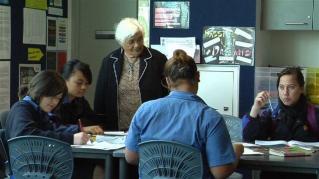-
Te Mana Kōrero Online
- Introduction
- Undertaking professional development
- Having high expectations
- Engaging Māori students
- Developing responsive and respectful relationships
-
Building partnerships
- Key research evidence
- Exploring the resources
- Some introductory points
- Fostering family-whānau-iwi involvement
- Encouraging family/whānau and iwi involvement
- Using family-whānau-iwi-community expertise
- Making families/whānau and iwi welcome
- Fostering communication
- Encouraging involvement
- Making students’ intended learning outcomes clear
- Learning opportunities
- Going into the community
- The benefits of responsive and respectful partnerships
- Building responsive school leadership
Section navigation
Key research evidence
As defined on the Ministry of Education’s home-school partnership website, home-school partnerships are:
… the shared relationships and initiatives through which the people who care for students in the home and community setting and the people who care for them in the school setting jointly promote the students’ learning and well-being. These students themselves are part of both these groups, which together make up the wider school community.
What are home-school partnerships?
The most effective school-family-whanau-iwi partnerships are ones in which all parties collaborate and find ways of working together to address issues around student engagement and achievement. Such collaboration links to the concept of ako, in that working together means school and family learning from each other about the student and their strengths and needs (Robinson, Hohepa & Lloyd, 2009). All partners set joint goals for student engagement and achievement and understand that each partner is accountable to the others for progress toward the goals. They each have a responsibility for ensuring that goals are being met; they each understand their roles in supporting students toward the goals; they value each other’s contributions toward meeting the goals; and they meet regularly to discuss progress toward them. Student learning is the main focus of effective school-family-whanau-iwi partnerships.
Effective school-family-whanau-iwi partnerships are “active, planned, dynamic, and flexible”. They are based on strengths rather than deficits.
Both school and home are hugely influential, and so it is very important for teachers, parents and students to work together, forging a common language and setting joint goals.
Effective home-school partnerships are dynamic
Developing mutually respectful school-family-whānau-iwi partnerships is not always easy. The home-school partnerships module cites Sonia Glogowski, who notes that:
… efforts by schools and parents or caregivers to form closer relationships have not always been successful. These efforts can be perceived by both parents or caregivers and teachers as shallow, ineffectual, confusing and frustrating … The reasons suggested for this include:
- a lack of awareness that language and literacy development are culturally embedded and that literacy practices can therefore differ enormously;
- the [un]willingness of school staff to venture out of the school environment and become more accessible;
- the perception held by some groups of the different roles of parents or caregivers and schools;
- parents’, caregivers’, or whānau members’ own educational experiences and their [in]ability and/or [un]willingness to seek dialogue or support;
- the realisation that it can take a considerable amount of time, trust and commitment to build successful partnerships.
Ministry of Education 2002, p. 6
However, many studies agree that finding this time, trust, and commitment is essential if learning is to be enhanced. Anthony and Walshaw, in a report on effective pedagogical approaches to learning in mathematics, assert that direct “parental involvement in classroom instructional tasks leads to positive learning outcomes” (p. 16). They suggest especially that students’ learning “benefits from parent involvement in the classroom when parents are given the opportunity to act as ‘subteachers’, providing instruction that models, reinforces and supports the teacher’s instructional purposes” (Anthony & Walshaw, p. 16).
In her important research on school-home partnerships, J. L. Epstein found that “teacher leadership played a major role in the extent to which parents became involved in their children’s in-school learning and sustained that involvement” (cited in Biddulph, Biddulph & Biddulph, The Complexity of Community and Family Influences on Children’s Achievement in New Zealand:Best Evidence Synthesis Iteration, 2003, p. 145). The same BES cites another American researcher’s finding, that “poorly designed or inappropriate programmes that are not responsive to families can be ineffective or even counterproductive” (H. Walberg, in ibid., p. 143).
Some researchers, for example, Bishop, Berryman, Tiakiwai & Richardson (2003) suggest that it is easier for families/whānau and iwi to participate in the learning of their tamariki if students are fully and meaningfully engaged in the learning process, particularly through a cultural lens that is relevant to them. If the whānau can relate to topics that their tamariki are studying, it is easier for them to contribute and discuss learning ideas and information with their tamariki. If they know exactly what their tamariki are trying to achieve as learners, they can assist their learning more confidently at home, and if they sense full engagement by their tamariki in the learning process, they are more motivated to support them in their learning. This reinforces the need for teachers to be culturally responsive not only with students but also with their families/whānau and iwi.
Many researchers also point to the importance of schools working closely with community expertise in order to raise student achievement levels. Community expertise encompasses everyone who has knowledge of the student, their learning and social backgrounds, and their cultural context and who can contribute to their school learning in in any way. This might include family, whānau or iwi members, respected community elders or even older students, in the context of a tuakana-teina relationship, all working in partnership with the school to raise student achievement.
The principles that contribute most significantly to building and sustaining strong and effective school-family-whānau-iwi links, from a school’s perspective, are neatly summarised in the are neatly summarised in the Complexity of Community and Family Influences BES as:
- Being genuinely non-judgmental about families and their circumstances, and recognising that families are important human resources in the educational process … It is essential that parents and children are shown respect as fellow human beings and that interactions with them reflect this respect …
- Working with parents and their children in a climate of equality to identify, understand and build on their experiences and strengths …
- Providing ongoing opportunities for informal, non-threatening contacts between parents and teachers, and parents and other facilitators.
- Providing support, while also recognising parents’ competencies, values, beliefs, expectations about learning/teaching/education and their home circumstances …
- Realising that parents’ initial responses are likely to be determined by their own schooling experiences and cultural backgrounds, and that these will affect their perceptions of what teaching is and subjects are …
- Supporting parents to make changes or develop alternative strategies over time …
- Encouraging parent-to-parent communication within communities, so that awareness, interest and confidence grow in multiple ways, and sharing of human and material sources is facilitated.
- Implementing new initiatives to support parents and their children on a small-scale initially.
Biddulph, Biddulph & Biddulph, 2003, p. 171
The Education Review Office (2008) says that, in order for home-school partnerships to be effective, four key success factors need to be in place:
- A shared understanding, by staff and parents, of the purposes of the partnership and how it fits with their beliefs about the purpose of schooling.
- A clearly articulated school philosophy in which home-school partnerships are viewed as integral to the work of the school.
- Principals who see the partnership as a way to improve the school’s performance.
- Teachers who have either been recruited because of their beliefs about the importance of home-school partnerships or have spent time thinking and talking about home-school partnerships and why they are important.
Cited in: Characteristics of effective-home-school partnerships.


